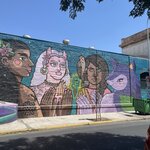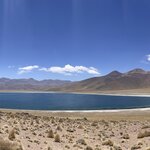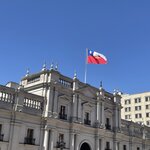
Highlights of Northern Chile

Overview
The challenge of visiting this great region is its size. From the Elqui Valley in the south to Arica in the north is a distance of some 1000 miles. Luckily the roads are generally in good shape, and decent signage makes it fairly easy to get around — either with a rental car or on Chile’s extensive bus network. If time is limited, however, you can add in a few flights between destinations to cut down on the long drives.
Guided tours are a good way to reach the more remote national parks, and you’ll find a dizzying assortment of offerings in places like San Pedro de Atacama, the tourist epicenter of the north. Other popular towns like Arica, Iquique, La Serena and Pisco Elqui are popular places for arranging tours.
It’s possible to cover the main sights in about two weeks, though an extra week will allow a more leisurely journey — with added time for worthwhile detours. You’ll find ample lodging options through the north, from budget-friendly hostels to high-end boutique hotels with swimming pools and lush gardens. Wherever you go, be sure to make advanced bookings during the high season (December through February).
San Pedro de Atacama

Gateway to some of Chile’s most surreal landscapes, this small, lively village attracts adventure seekers from across the continent. There’s much to see here, from otherworldly rock formations to sparkling salt lakes where flamingoes still roam freely along the shoreline.
A short drive north of town lies the so-called Valle de la Muerte (Valley of Death), with craggy mountain peaks and towering sand dunes that make a fine setting for sandboarding — just like snowboarding but without the frosty downside. Afterwards, you can head to the nearby Valle de la Luna (Valley of the Moon), where you can scramble up to the top of rocky heights for fabulous views of the distant mountains. Come at sunset to see the landscape infused with hues of gold, pink and lavender.
Northeast of San Pedro, the Geysers of El Tatio are an unforgettable sight. Ringed by volcanoes, these 64 geysers erupt in swirling columns of steam and bubbling fumaroles with the scent of sulfur lingering in the air. The best time to go is at sunrise when the first rays of dawn light up the swirling mists.
South of San Pedro, there’s much more to see, including the Laguna Cejar, where you can float in a salt lake and spot flamingoes on the distant shore. Further out, the high-altitude lakes of Miscanti and Miñiques are a stunning deep blue dramatically set against a backdrop of conical Andean peaks. Keep driving south to reach Piedras Rojas (Red Rocks), which has Mars-like formations overlooking a blue-green lagoon.
Chat with a local specialist who can help organize your trip.
Elqui Valley

This verdant valley six hours north of Santiago is home to frozen-in-time villages, mountain scenery and rolling hills carpeted with vineyards and pisco distilleries. This potent brandy has been produced here since the 16th century and is put to good use in the much-loved pisco sour, a cocktail claimed by both Peru and Chile as the national drink.
A fine starting point for venturing into the valley is Vicuña, a peaceful village of colonial buildings. You'll also find here a museum devoted to the Nobel Prize-winning poet Gabriela Mistral, who grew up in these parts. Vicuña is an ideal base for visiting pisco vineyards. Pisquera Aba offers guided tours that show all aspects of production, followed by tastings of the fiery elixir.
Astronomical observatories dot this region, which is a testament to the clarity of the night skies far from big cities and other sources of light pollution. Don’t miss the chance to gaze through telescopes at distant galaxies and globular clusters. Alfa Aldea offers small-group experiences led by research astronomers. Wine and hot soup are included.
The Atacama Desert

Welcome to the driest desert on the planet! Sandwiched between the Pacific Ocean and the Andes Mountains, the Atacama Desert runs for some 600 miles along northern Chile and encompasses over 40,000 square miles. On average, only half an inch of rain falls annually, though in some places precipitation has never been recorded.
This vast, mineral-rich area is home to many mines, including one of the world’s largest open-pit copper mines at Chuquicamata. Near Copiapó, you can visit the site of the Mina San José, where 33 Chilean miners were trapped deep underground for some 70 days in 2010. One of the miners who experienced the ordeal today offers tours of the site (above ground only since the mine remains closed) and gives a context to the harrowing ordeal that was followed by millions around the world.
The Atacama Desert hides many surprises. Age-old geoglyphs dot the landscape near Iquique. At Pintados, you’ll find more than 400 drawings on hillside slopes. These pre-Colombian artworks depict hunting scenes, wildlife (including whales and other marine creatures), and mysterious designs, some of which are over 1000 years old.
Around 35 miles north of Pintados, you’ll find the abandoned mining town of Humberstone. Once home to some 3500 residents, the now empty village lies eerily abandoned. You can wander along once bustling main streets, through the empty shells of a church, a theater, a hospital and other buildings overlooking the overgrown plaza at the town center. Come early or late in the day to have this ghost town largely to yourself.
The North Coast

Stick to the coast of northern Chile and you won’t lack for attractive beaches and picturesque seaside towns. Bahia Inglesa, with white-sand beaches backed by rocky outcrops, is a laid-back spot for indulging in a bit of seaside action. You’ll find excellent seafood eateries, attractive seafront hotels and a host of tours on offer, including visits to Pan de Azucar desert national park to the north.
Up near the border of Peru, the mid-size city of Arica has wide-ranging appeal. Lovely beaches, excellent surf breaks and some of the best dining north of Santiago makes it worth your while to stick around a few days. The pretty town plaza is flanked by the striking San Marcos Cathedral designed by Alexandre Gustave Eiffel; this cast iron church was built before Eiffel went on to create his better known Parisian landmark.
Just outside the colonial center, you can take a short but steep path to the top of El Morro de Arica, a headland that offers fantastic views of the city and the seaside beyond. Along the way uphill be sure to stop in the Museum de Sitio Colón 10, a small museum that houses several dozen Chinchorro mummies that were unearthed on this site. Outside of town, the Museu Arqueológico San Miguel de Azapa contains even older mummies — indeed the oldest known mummies on earth — in a thoughtfully designed museum in the Azapa Valley.






